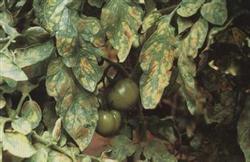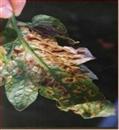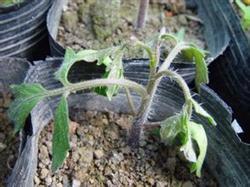What agents are used to control tomato leaf mildew?

Leaf mildew is a common disease in tomato. Although it does not directly infect the fruit, it will lead to the decrease of leaf function and affect the yield and quality. In production, some farmers often report that it is difficult to control leaf mold, and the effect is not obvious after spraying. The reason for the poor control effect is mainly due to improper prevention and control methods, and the following four points should be paid attention to when applying pesticide. There are many drugs for the control of tomato leaf mold, including preventive chlorothalonil, therapeutic carbendazim, flusilazole, difenoconazole and so on. Early prevention and early treatment of tomato leaf mildew is an airborne disease. Once the pathogen infects and produces disease spots, as long as there is enough humidity in the greenhouse, the disease will spread quickly. To prevent tomato leaf mildew, preventive medicine should be sprayed every 10 days from the seedling stage, and should be sprayed every 7 days during the first to second panicle flower setting period of tomato. After the appearance of disease spots in the lower leaves, therapeutic agents should be sprayed as soon as possible. Tomato leaf mildew at the spraying site usually starts from the lower leaves of the plant, and the plant located at the corner of the south shed is usually the first to occur. Therefore, the focus of spraying prevention is on the lower leaves of the plant and the plants in the south of the greenhouse. Focus on spraying to protect the middle and upper functional leaves. Many azole fungicides have high control effect on tomato leaf mold, but these fungicides (except difenoconazole) usually inhibit the growth of tomato. Therefore, the tomato fruit expansion period can not continuously spray a large number of azole fungicides, so as not to inhibit the fruit expansion.
- Prev

How to use medicine to prevent tomato from growing "black hair"
Leaf mildew is a common disease in tomato. Although it does not directly infect the fruit, it will lead to the decrease of leaf function and affect the yield and quality. In production, some farmers often report that it is difficult to control leaf mold, and the effect is not obvious after spraying. The cause of poor control effect is mainly due to improper prevention and control methods, and attention should be paid to the following.
- Next

Methods to prevent Tomato stunting Disease
Tomato quenching disease mostly occurs in the seedling stage, seeds are vulnerable before unearthed, often appear rotten seeds, dead seedlings, quenching and other symptoms. The prevention and control methods are as follows: 1. Sterilize the seedling bed and choose a place with slightly higher terrain to facilitate drainage. 2, carry on the management to the seedling stage, sow seed.
Related
- Where is it suitable to grow horseradish in China? it is expected to see the middle altitude horseradish in Alishan.
- How to prevent tomato virus disease reasonably? (Control methods included)
- Many people like to plant towel gourd on the balcony. What are the main points of this method and management?
- What crops can chili peppers be mixed with?
- Fertilization techniques and matters needing attention in Tomato
- What are the grafting techniques for peach seedlings in spring?
- Harm and control methods of root swelling disease of Chinese cabbage
- What are the pests of sweet potatoes? How to prevent and cure it?
- Symptoms, causes and Control methods of navel Rot in Tomato
- The cause of "Cucumber rotten bibcock" in Farmers' planting Cucumber and its Control Plan

